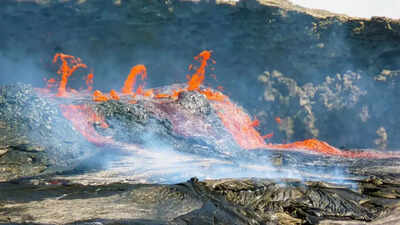In the Afar Depression of East Africa, a geological hotspot where three tectonic plates converge, scientists have discovered that lava from the Earth's mantle is playing a vital role in the continent's gradual split. This groundbreaking research suggests that upwellings from the mantle beneath the region are not uniform. Instead, they surge in complex waves of molten material. This activity is causing volcanic eruptions and earthquakes while simultaneously weakening the Earth's crust. The result of this ongoing process? The slow but steady formation of a new ocean that will eventually separate the Horn of Africa from the rest of the continent.

Image: Dr Derek Keir, University of Southampton/ University of Florence
Researchers from the University of Southampton and Swansea University analyzed lava samples from over 130 young volcanoes in the Afar region. Their analysis indicated that the mantle beneath East Africa exhibits a unique pulsing behavior, with partially molten rock rising to the surface in distinct surges. Each pulse possesses a unique chemical composition, revealing that the mantle is not a uniform plume but a complex arrangement of different materials. The thickness and movement of the overlying tectonic plates significantly influence this dynamic behavior.
In areas with rapid movement, such as the Red Sea Rift, mantle flow is concentrated and intense. Conversely, in regions with slower rifting, it spreads out more gradually. These pulses travel through thinned sections of the Earth's crust, making them more vulnerable to volcanic eruptions. This chemical "striping" in the lava, similar to cardiovascular rhythms, mirrors the Earth's internal tempo. This provides insights into the connection between surface volcanic activity and processes occurring far below the surface.
The plume's activity is also eroding the lithosphere. In some parts of the Afar Depression, Earth's outer shell is just 15 kilometers thick. As the plates continue to stretch and thin, they create pathways for even more lava to reach the surface, triggering cycles of volcanic eruptions and seismic events, similar to the forces that shaped the Atlantic Ocean millions of years ago.
The geological activity in the Afar region is part of a broader process called continental rifting, where the African, Arabian, and Somali tectonic plates are diverging. As they separate, the resulting space is filled with rising magma and new crust. Eventually, seawater is expected to flood the region, forming a new ocean basin akin to the Atlantic Ocean, which once separated Europe and North America.
The ongoing volcanic activity is actively reshaping the landscape. Lava from the Erta Ale volcano covers vast areas of Ethiopia, while frequent earthquake swarms denote zones of intense tectonic stress. The Boset Volcano displays layers of volcanic deposits, demonstrating the long-term accumulation of geological events driven by the mantle’s upwelling.
These discoveries offer a glimpse into the birth of an ocean and have implications for understanding Earth's climate and history. Similar mantle plumes in the past have created massive volcanic provinces, such as the North Atlantic Igneous Province, which contributed to significant climate shifts and potential mass extinctions through the release of CO₂ and sulfur dioxide.
Scientists stress that collaboration among institutions and disciplines is crucial for understanding these complex dynamics. Future research will focus on mapping mantle flows beneath other thinning tectonic plates and predicting how these deep forces shape surface geology. The Afar region serves as a natural laboratory to observe the connection between Earth's interior and its evolving surface.
Newer articles
Older articles
 Moto G54 Gets Significant Price Cut in India, Making Budget Smartphone Even More Appealing
Moto G54 Gets Significant Price Cut in India, Making Budget Smartphone Even More Appealing
 Africa's Rift Valley: Mantle Upwelling Drives Continent's Split and Birth of New Ocean
Africa's Rift Valley: Mantle Upwelling Drives Continent's Split and Birth of New Ocean
 X Cracks Down: Over Half a Million Indian Accounts Suspended for Policy Breaches
X Cracks Down: Over Half a Million Indian Accounts Suspended for Policy Breaches
 Vijay Sethupathi Apologizes Amid Controversy Over Son Surya's Debut Film 'Phoenix'
Vijay Sethupathi Apologizes Amid Controversy Over Son Surya's Debut Film 'Phoenix'
 Jadeja's Accuracy Questioned: Ex-India Pacer Slams Spin Strategy in England Test Loss
Jadeja's Accuracy Questioned: Ex-India Pacer Slams Spin Strategy in England Test Loss
 IRCTC's AI Chatbot Revolutionizes Train Ticket Booking, Refunds, and Information Access
IRCTC's AI Chatbot Revolutionizes Train Ticket Booking, Refunds, and Information Access
 Ashada Gupt Navratri 2025: Unveiling Dates, Sacred Rituals & Hidden Significance of the Monsoon Festival
Ashada Gupt Navratri 2025: Unveiling Dates, Sacred Rituals & Hidden Significance of the Monsoon Festival
 Google Maps Enhances Directional Accuracy with Fused Orientation Provider Update
Google Maps Enhances Directional Accuracy with Fused Orientation Provider Update
 xAI to Open Source Grok, Democratizing Access to Musk's AI Chatbot
xAI to Open Source Grok, Democratizing Access to Musk's AI Chatbot
 Android Users Urged to Patch Now: Critical Security Flaws Expose Devices to Attacks
Android Users Urged to Patch Now: Critical Security Flaws Expose Devices to Attacks